If art preserves the culture of the Apsáalooke people, then Apsáalooke women are the keepers of that culture, cultivating it to reflect the modern day.
Fashion designer Bethany Yellowtail grew up “riding horses and running in the fields and swimming in the river and being around [her] people” on the Apsáalooke (Crow) Nation and Northern Cheyenne Indian reservations in southeastern Montana. She knows firsthand the importance of art — beadwork, textiles, quillwork — to sustaining Indigenous traditions, and in 2015 she turned that knowledge into her own brand: B.Yellowtail.
A year later, she created the B.Yellowtail Collective, made up of Native artists, to foster economic opportunities for their communities. Many of those artists and artisans are women — spanning across tribes and peoples — but all of them preserve their culture and move it forward through their medium of choice.

From left, JoRee LaFrance, KamiJo White Clay, Rustin Lane LaFrance and Nina Sanders model B.Yellowtail’s Heritage Collection.
(Erica Elan)
Yellowtail and her team have leaned into their values as a Native-owned business that’s “anchored in community.” Consignment artists within the Collective typically receive 70% of profit from retail sales and for a portion of the pandemic, the brand has upped that to 100%. Those extra proceeds have, of course, supplemented artists’ income through the past year, but the relationship is symbiotic: without the work of those artists, B.Yellowtail as it stands wouldn’t exist. And Native culture would feel the loss.
Dewanda Little Coyote joined the Collective about a year and a half ago, she said, and since then it’s made a world of difference. When her husband and grandson both contracted the coronavirus, she had to take off work. “And it was just, like, thank goodness I had the Collective,” she said. “Because I was able to carry us through.”
Little Coyote is the mother of Yellowtail’s oldest brother — Yellowtail calls her “Mom” or “Mama D.” Family is deeply important to the Northern Cheyenne Nation they share, Little Coyote said. So is art, which often runs in the family — and along the matriarchal side.
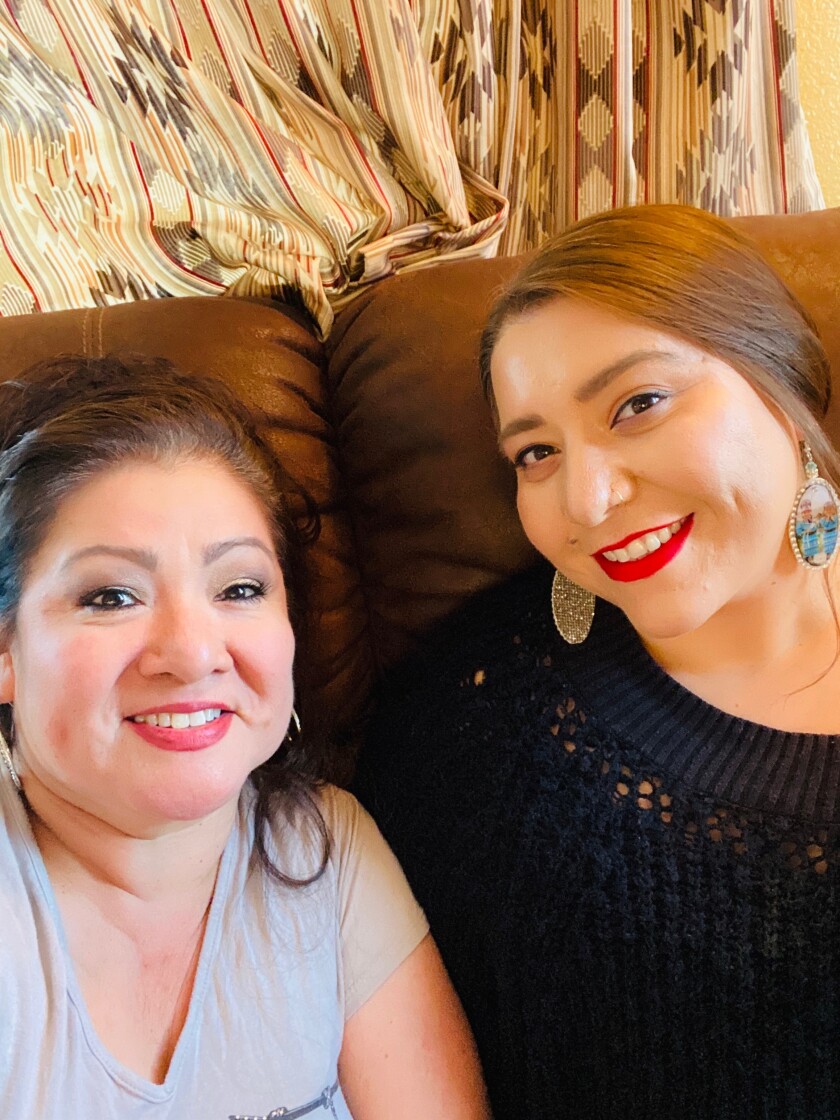
Dewanda Little Coyote, left, with Bethany Yellowtail.
(Dewanda Little Coyote)
While Yellowtail learned to sew from her female relatives, Little Coyote picked up her entrepreneurial spirit from her parents, who owned a gift shop.
“My parents said, ‘If you got hands, create something. Do something, and make a living off of that.’” she said. “My father made war bonnets and my mother designed beautiful artwork on ceramic pots, and she did a beautiful collaborative china doll with a turquoise stone in it, with the feathers along the side.”
After her parents passed, the artist began dabbling in beading earrings herself. Dentalium, a tusk shell often used in Indigenous jewelry, caught her eye in particular.
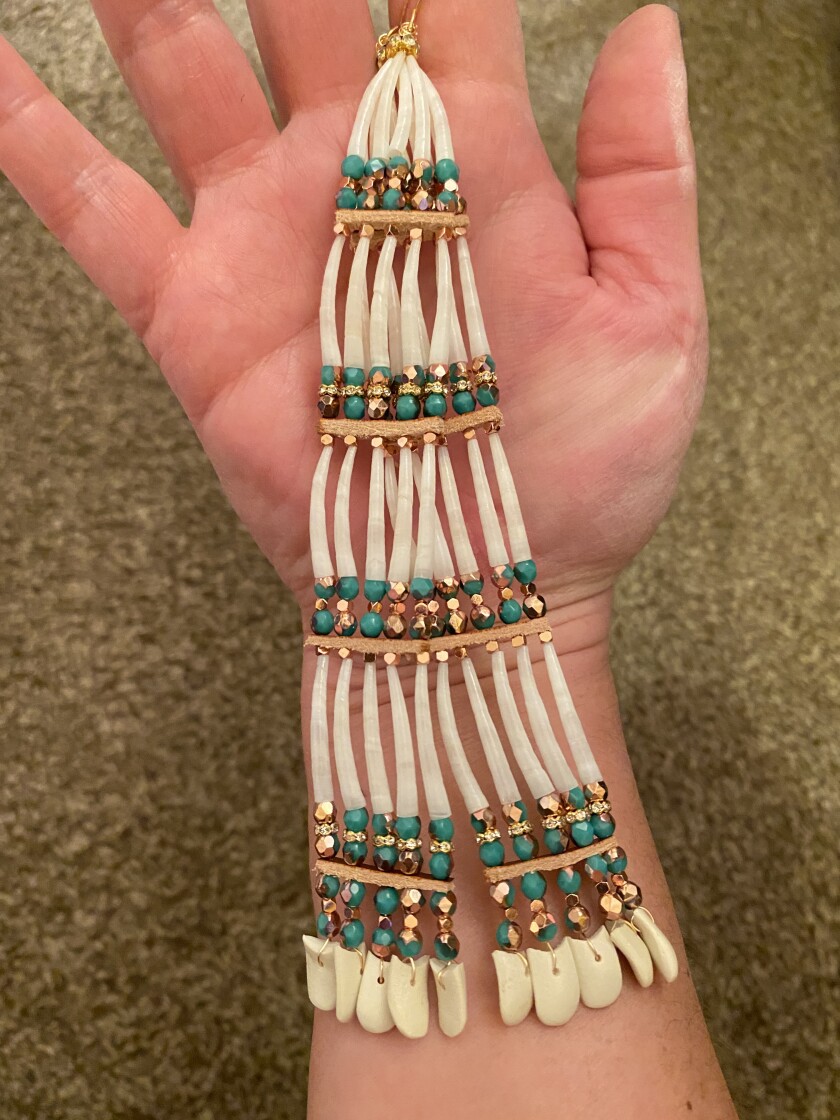
Little Coyote displays a four-tier dentalium earring that she made, complete with mini elk teeth at the bottom.
(Dewanda Little Coyote)
“I love it, because back in the day, our Cheyenne women wore a lot of dentalium,” she said. “So I wanted to give a contemporary look to that — to what our ancestors wore.”
Little Coyote is one of about 40 artists who currently comprise the Collective, according to Yellowtail. Of the 19 creatives the brand lists on its website, 14 of them are women. And many of them pay homage with their work to the women who raised them.
While she sells her beaded ochanku (“well-traveled road”) earrings on B.Yellowtail’s site, Collective artist Molina Parker also makes Tunwin or “auntie” earrings with her own aunt, Lorri Ann Two Bulls.
“I thought it would be really cool to try to collaborate in some way,” Parker said. “And that’s what I wanted to use. She’s my auntie, and she helped me. I wanted to do something that was significant in that way.”
Those Tunwin earrings feature hand-painted clay Lakota dancers with beaded tops. (Parker hails from the Oglala Lakota and Northern Cheyenne Nations.) The duo created a pink Owicikapte Win (“Battle Survivor Woman”) pair to honor Parker’s grandmother, who died from breast cancer.
Matriarchs have always played a significant role in Parker’s life — she learned to bead from the women around her. Now, her 6-year-old daughter is learning to bead at the same age she did. They sit side by side, beading — and keeping tradition alive.
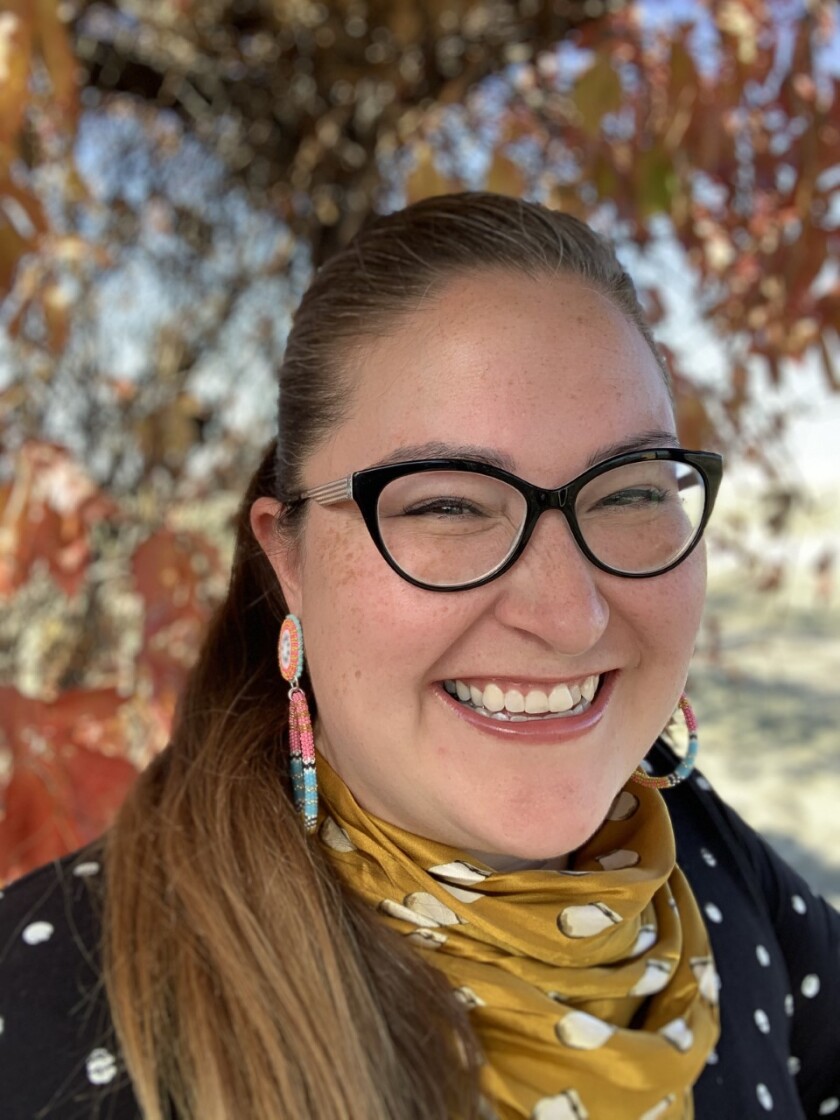
Molina Parker smiles in a B.Yellowtail elk tooth silk scarf.
(Molina Parker)
Yellowtail herself learned sewing from her aunts and grandmothers before moving to Los Angeles in 2007 to study fashion design. Circles run small in the Crow community — Yellowtail’s grandfather and Collective artist Nina Sanders’ grandmother are cousins. Although the two didn’t get close until about 2015, now they feel more like sisters.
Like Yellowtail, Sanders learned from matriarchs: Her great-grandmother made sacred bundles collected by museums. When she started to do museum work of her own, the curator and the designer grew closer.
An April 2019 article titled “Counting Coup: Fashion and the Field Museum” that Sanders wrote for Native American Art Magazine detailed the beginning of their Chicago collaboration. “The both of us have come a long way from being little girls on the Crow reservation,” Sanders wrote at the time. “We are now women and about to embark on a very important and serious venture that has the potential to positively influence people from all walks of life.”
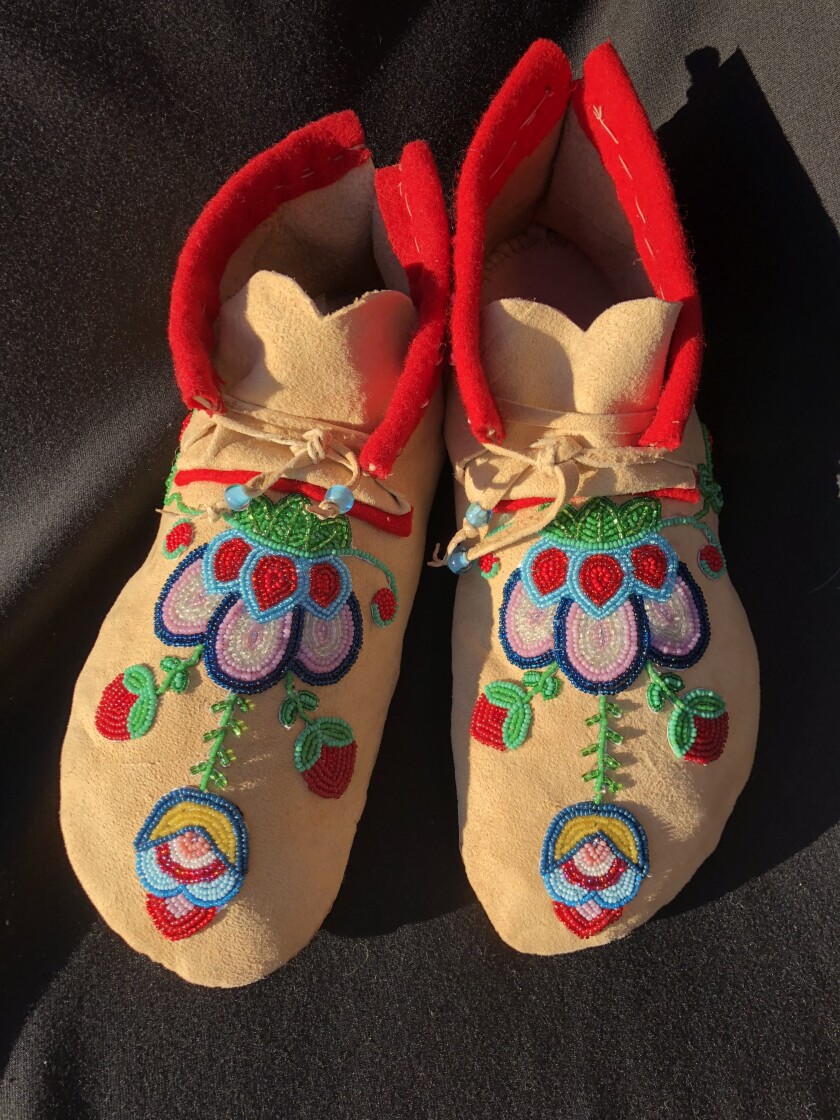
Sanders made these moccasins, which served as the design for several pieces from B.Yellowtail’s most recent capsule collection.
(Nina Sanders)
Sanders curated the Apsáalooke Women and Warriors exhibition, now on display at the Chicago Field Museum. A collection of bright B.Yellowtail dresses serves as the grand finale to the exhibit. The “Nina” maxi dress there — named for Sanders — features B.Yellowtail’s signature elk tooth motif on an evergreen fabric.
Most of the art available at B.Yellowtail is wearable, from the Heritage Collection’s blouses and blazers to the accessories and moccasins of the Collective. Artist Carrie Moran McCleary, of the Little Shell Chippewa Tribe, is an exception to the rule.
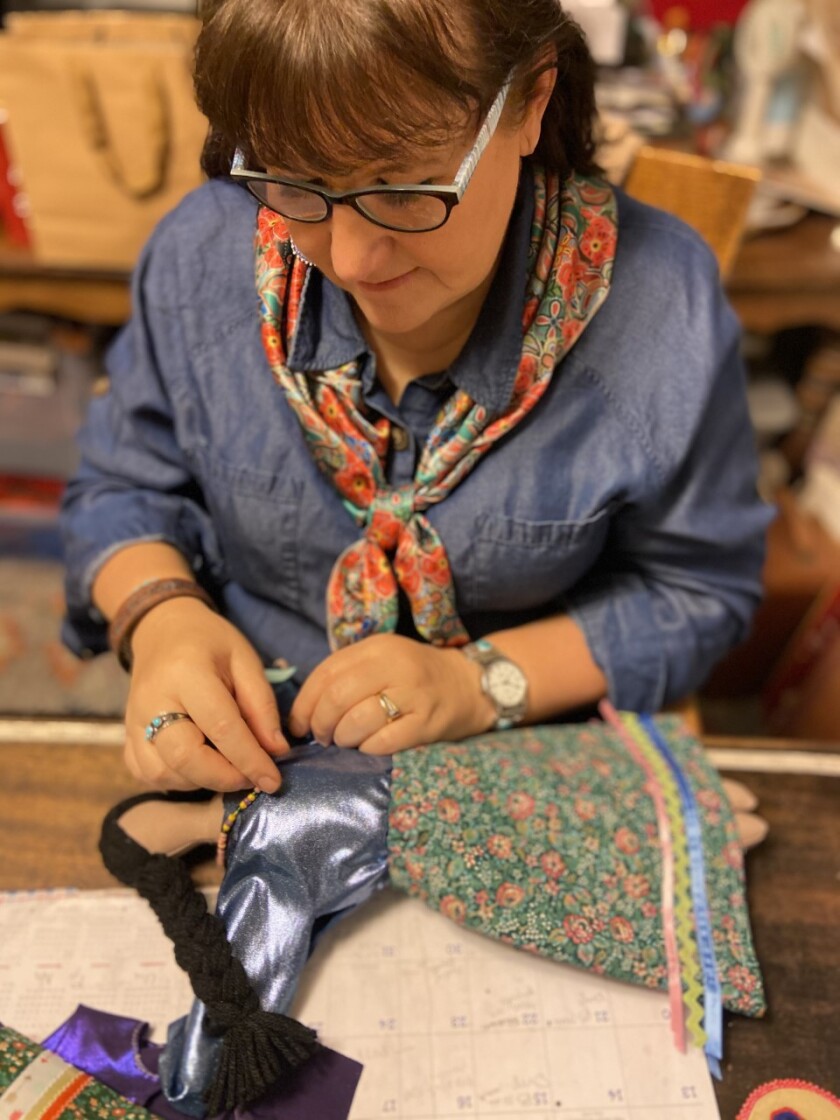
McCleary works on one of her Fierce One dolls.
(Carrie Moran McCleary)
McCleary sews and sells “Fierce One” dolls, representing young Indigenous people full of potential: doers, thinkers and innovators. Each one features a different name and backstory. And each takes Carrie Moran McCleary about 10 hours to make by hand.
Although McCleary is primarily a beader, she got her start sewing in high school. Between two sewing machines and four sisters, the family’s back-to-school clothes were an in-house affair. Decades later, she returned to sewing with the Fierce One dolls. Her favorite was named after her mother, Dennie.
“The Dennie doll always wanted to be a teacher, and her dream was to someday go to school and become [one],” McCleary said. “And that got to me, because my mom, … she raised all these kids, she’s lost three husbands in the middle of that. … My mom is the original fierce woman.”
The artist is thinking of sewing a Fierce One doll based on Yellowtail, she said. After all, Yellowtail is the fierce woman who drew the Collective together. There, Native women support Native women — and matriarchal art evolves.
from Lifestyle https://ift.tt/2PrHVyc
via IFTTT

comment 0 Comment
more_vert